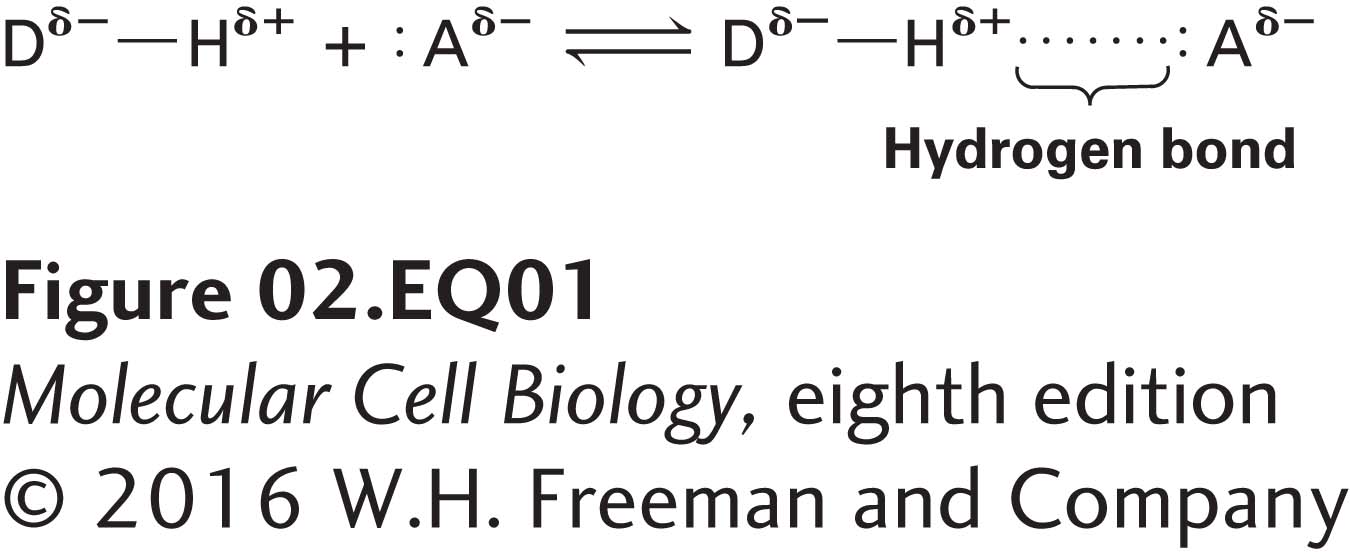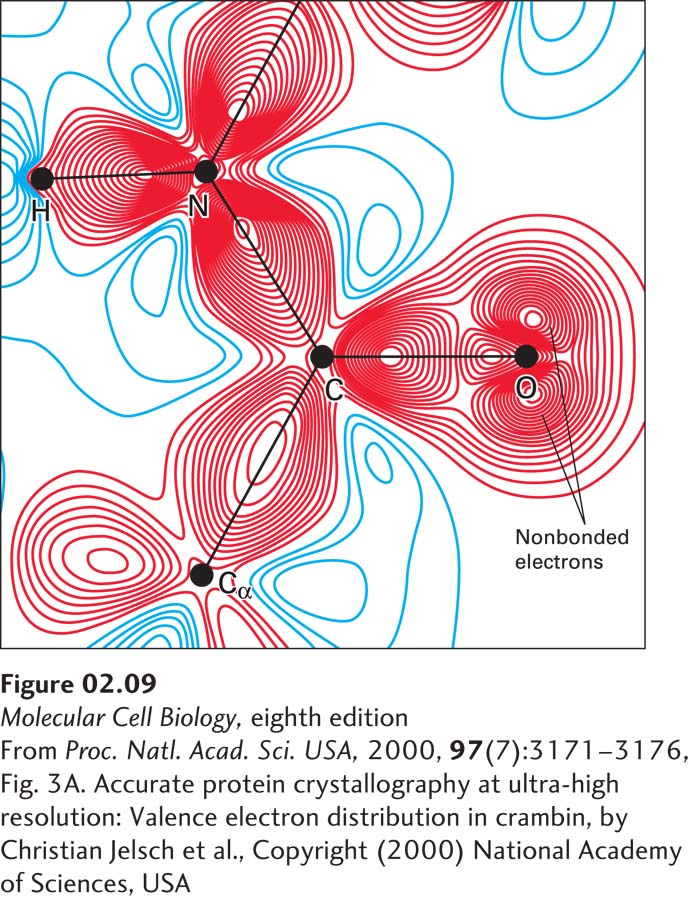Hydrogen Bonds Are Noncovalent Interactions That Determine the Water Solubility of Uncharged Molecules
A hydrogen bond is the interaction of a partially positively charged hydrogen atom in a dipole, such as water, with unpaired electrons from another atom, either in the same or in a different molecule. Normally, a hydrogen atom forms a covalent bond with only one other atom. However, a hydrogen atom covalently bonded to an electronegative donor atom D may form an additional weak association, the hydrogen bond, with an acceptor atom A, which must have a nonbonding pair of electrons available for the interaction:

The length of the covalent D–H bond is a bit longer than it would be if there were no hydrogen bond because the acceptor “pulls” the hydrogen away from the donor. An important feature of all hydrogen bonds is directionality. In the strongest hydrogen bonds, the donor atom, the hydrogen atom, and the acceptor atom all lie in a straight line. Nonlinear hydrogen bonds are weaker than linear ones; still, multiple nonlinear hydrogen bonds help to stabilize the three-dimensional structures of many proteins.
Hydrogen bonds are both longer and weaker than covalent bonds between the same atoms. In water, for example, the distance between the nuclei of the hydrogen and oxygen atoms of adjacent, hydrogen-bonded water molecules is about 0.27 nm, about twice the length of the covalent O–H bonds within a single water molecule (Figure 2-8a). A hydrogen bond between water molecules (approximately 5 kcal/mol) is much weaker than a covalent O–H bond (roughly 110 kcal/mol), although it is stronger than many other hydrogen bonds in biological molecules (1–2 kcal/mol). Extensive intermolecular hydrogen bonding between water molecules accounts for many of water’s key properties, including its unusually high melting and boiling points and its ability to dissolve many other molecules.

FIGURE 2-8 Hydrogen bonding of water with itself and with other compounds. Each pair of nonbonding outer electrons in an oxygen or a nitrogen atom can accept a hydrogen atom in a hydrogen bond. The hydroxyl and the amino groups can also form hydrogen bonds with water. (a) In liquid water, each water molecule forms transient hydrogen bonds with several others, creating a dynamic network of hydrogen-bonded molecules. (b) Water can also form hydrogen bonds with alcohols and amines, which accounts for the high solubility of these compounds. (c) The peptide group and the ester group, which are present in many biomolecules, commonly participate in hydrogen bonds with water or polar groups in other molecules.
The solubility of uncharged substances in an aqueous environment depends largely on their ability to form hydrogen bonds with water. For instance, the hydroxyl group (–OH) in alcohols (–CH2OH) and the amino group (–NH2) in amines (–CH2NH2) can form several hydrogen bonds with water, which allows these molecules to dissolve in water at high concentrations (Figure 2-8b). In general, molecules with polar bonds that easily form hydrogen bonds with water, as well as charged molecules and ions that interact with the dipole in water, can readily dissolve in water; that is, they are hydrophilic. Many biological molecules contain, in addition to hydroxyl and amino groups, peptide and ester groups, which form hydrogen bonds with water via otherwise nonbonded electrons on their carbonyl oxygens (Figure 2-8c). X-ray crystallography combined with computational analysis permits an accurate depiction of the distribution of the outermost unbonded electrons of atoms that can participate in hydrogen bonds as well as the electrons in covalent bonds, as illustrated in Figure 2-9.

FIGURE 2-9 Distribution of bonding and outer nonbonding electrons in the peptide group. Shown here is a peptide bond linking two amino acids within a protein called crambin. No protein has been structurally characterized at higher resolution than crambin. The black lines represent the covalent bonds between atoms. The red (negative) and blue (positive) lines represent contours of charge determined using x-ray crystallography and computational methods. The greater the number of contour lines, the higher the charge. The high density of red contour lines between atoms represents the covalent bonds (shared electron pairs). The two sets of red contour lines emanating from the oxygen (O) and not falling on a covalent bond (black line) represent the two pairs of nonbonding electrons on the oxygen that are available to participate in hydrogen bonding. The high density of blue contour lines near the hydrogen (H) bonded to nitrogen (N) represents a partial positive charge, indicating that this H can act as a donor in hydrogen bonding.
[From Proc. Natl. Acad. Sci. USA, 2000, 97(7):3171–3176, Fig. 3A. Accurate protein crystallography at ultra-high resolution: Valence electron distribution in crambin, by Christian Jelsch et al., Copyright (2000) National Academy of Sciences, USA.]


